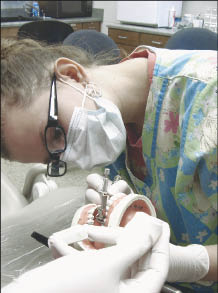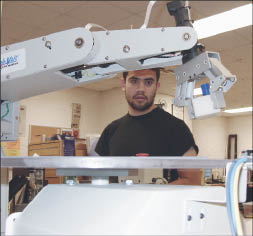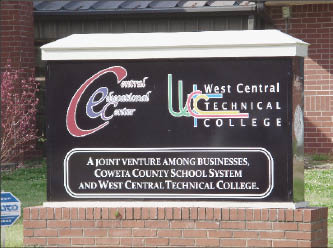 |
|
Skills with teeth: Pam Fuller, 17, practices using a dental instrument in her dental assisting class at Central Educational Center. Photo: Jamaal Abdul-Alim |
Newnan, Georgia—As a high school dropout hooked on methamphetamine at age 15, Chelsea Thomas had a simple answer for anyone who asked whether she planned to go to college: Never.
Then she cycled through a series of low-paying, dead-end jobs at several warehouses. At one point, she found herself earning $7 an hour packing ketchup.
“I knew that, going from warehouse to warehouse, … I was going to have to do something to get into school,” Thomas says.
For Thomas, “something” meant enrolling in Central Educational Center (CEC), a publicly funded charter school here that has distinguished itself within the “career academy” movement that is drawing increased attention from educators, youth workers, business leaders and others who believe in the transformative power of career and technical education.
The school differs from most career academies in that it offers career training to high school students and adults in the same setting, through an innovative model that relies heavily on consulting with area businesses to help the school achieve its mission of ensuring a viable workforce.
For Thomas, now 20, becoming more employable took just 36 weeks of course work, which she completed last month when she earned a certificate in advanced dental assisting through Central Educational Center’s Dental Assisting Program.
 |
|
A firm grasp: Aaron Yin, 17, programs a robotic arm to pick up a plastic block and put it on a conveyor belt in the pre-engineering class at Central Educational Center. Photo: Jamaal Abdul-Alim |
Data from the U.S. Bureau of Labor Statistics show Thomas’s employment prospects are “excellent.” Further, dental assistants earned an average of $15.95 an hour in 2008 – more than double the wage Thomas earned in her warehouse jobs. Even though many dental assistants are trained on the job, those with credentials like Thomas’ stand a better chance of getting hired, says Martha S. Phillips, executive director of the Georgia Dental Association.
For Thomas, the prospects of getting a meaningful job have removed her appetite for getting high.
“Now I know who I am and what I want to do in life,” says Thomas, who dreams of one day starting a charity for poor children who need dental braces.
At a time when career and technical education often take a backseat to standardized tests and other measures of achievement, Thomas’ story represents one of many reasons youth advocates say career academies such as CEC should be a more prominent feature in American education.
 |
|
Visitors to the Central Educational Center are greeted by this sign that highlights the school’s relationship with West Central Technical College, which is located on the same campus. Photo: Jamaal Abdul-Alim |
“Innovations like CEC are really the answer for all of these disconnected students,” says Mike Parry, vice president of Butler Tech, a network of career and technical schools based in Hamilton, Ohio, who recently visited CEC as a member of the Career Tech Baldrige Network, which aims to improve performance and ensure quality in the career and technical education field.
His view is supported by a growing body of research that shows career academies are having a positive impact on attendance, grades, test scores, high school graduation rates and post-secondary transition rates, and, ultimately, on students’ earnings later in life, according to a March issue brief from the Association for Career and Technical Education (ACTE), “The Role of Career Academies in Education Improvement.”
“It is time to focus efforts to reform high school education in the United States on proven strategies like career academies,” the ACTE brief says. “Academies can play a central role in high school improvement by integrating relevant career themes, engaging business and industry leaders in the education process and, as a result, driving academic achievement.”
But academic achievement is not the ultimate goal here at CEC, a school that sits on a 20-acre campus about 40 miles southwest of Atlanta, in this historic city where the streets are dotted with stately antebellum homes, and a statue and historic markers in the town square pay homage to Confederate war heroes.
Instead, the ultimate goal is to make students employable, which benefits students and employers alike.
“That CEC responds to business simply means that we have a different definition of the ultimate customer,” says Mark Whitlock, CEO of CEC. “Rather than the government mandate, or the university, CEC looks beyond, to the ultimate aim of most students – economic viability as an individual.”
That approach resonates with others who are seeking to replicate CEC, not only here in the Peach State but throughout the United States. For instance, when CEC is replicated in Baton Rouge, La., in 2011, leaders there say they don’t want to do anything different from what’s being done here in Newnan.
“We simply want to replicate it,” says Steve Hicks, president of Provident Resources Group, a Baton Rouge nonprofit that is leading the effort in Baton Rouge. “We can only pray that we can emulate it.”
Unlike most students at CEC, Thomas, who carpools there from nearly an hour away, found her way into CEC after leaving high school. Statistics suggest that if a CEC-type school had been available in her county before she dropped out, she probably wouldn’t have left high school in the first place.
Since CEC opened its doors here in 2000, it has been credited with helping to lower the local dropout rate. Thomas’ story shows the school’s potential for attracting out-of-school youths who want to obtain post-secondary training or a degree.
CEC is also considered a boon for area businesses, which have long complained that the public school system wasn’t producing graduates who possessed the skills needed for today’s jobs. Whitlock often talks of how Yamaha, a key CEC partner that donated $40,000 for the school’s pre-engineering lab, was once on the verge of locating an expansion facility away from Newnan, until CEC opened its doors in 2000. The reason for the change, he says, is that the company realized it could draw employees from the school.
Some businesses aren’t waiting for CEC students to graduate.
NuLink, Newnan’s cable provider, is building a TV production studio at CEC and intends to call on students who are looking for experience to shoot, edit and produce programming for the company’s 16,000 subscribers.
“It actually gives us more hands and feet on the street,” Lana Mobley, vice president and general manager of NuLink, says of the arrangement.
Students have already shot, edited and produced video of veterans’ programs, local parades and sports events, and there are plans to do pre- and post-game live feeds and launch a Good Morning America-style program fall.
“It’s advantageous for us and gives students the experience they need to have in their portfolio,” Mobley says.
She says NuLink would like to take on interested CEC students as interns once they go to college, and possibly hire them in the future, because they’ll already know how to operate NuLink’s system and equipment. She says she is hopeful that NuLink can hire the students it trains, but concedes the prospects are distant, given the small size of the company.
Similarly, beyond anecdotes, the extent to which Yamaha or other businesses are actually hiring students from the school is unclear. Like education throughout America, CEC does not follow its alumni long enough to track their success – one reason that even the man whose book was a catalyst for establishing the school calls it an “approximation” of his original vision.
Still, millions of dollars are being spent to replicate the school throughout Georgia, all to the delight of educators who believe schools like CEC can help remedy the problem of educational disinterest among youth.
Skills that Matter
Established as a public charter school, CEC offers career and technical training in such fields as video broadcasting, construction and engineering. The school occupies the building that housed the “black high school” under segregation, as well as a $7 million addition that was built with a state grant. Its partner, West Central Technical College, has a branch on campus.
The high schoolers at CEC come from one of Coweta County’s three public high schools, most having learned about it from friends or during classroom presentations by CEC staff at those schools, from administrators and counselors, or during job fairs. They attend CEC during part of the day but spend the rest of their time at their regular schools.
Courses are taught by instructors who have had experience working in the fields in which they teach – such as Sandee Kirk-Beard, an instructor from the technical college who runs CEC’s Dental Assisting Program, and who has worked as a chair-side dental assistant in Kentucky, North Carolina and Georgia.
This year, CEC served just over 1,300 high school students, including about 250 who were dually enrolled at West Central Technical College. CEC typically serves about 550 over-18 students per quarter.
As a public charter school, CEC is free for high school students up to age 21. Students can also have a HOPE Grant pay tuition charges for the Technical College Certificate and Technical College Diploma programs at CEC.
Thomas used a state HOPE grant to enroll at West Central Technical College, but is still considered a CEC student, because CEC houses the dental assisting program in which she is enrolled.
For over-18 students like Thomas, CEC provides a second chance to get industry-specific training that could lead to an associate’s degree. For high school students, the CEC model provides early exposure to career training and, for those who are dually enrolled in technical college classes, a head start on college.
“It’s better to come here first, try it out, see if you want to do it before going into the real world,” says Garrick Augustus, 17, a senior at East Coweta High School, who says CEC has solidified his plans to become a mechanical engineer.
He spoke while sitting at Station 6, the electricity and electronics cell in the pre-engineering lab at CEC, working on a Lab-Volt 3345-00 – a device to help better understand electronic sensors. “Say you’re working with Brink’s,” Augustus explained, referring to the armored car company. “It teaches you strategic places to place motion sensors, line sensors and how to wire them.”
“I think the best thing about the program is in 18 weeks of their time, [students] can determine whether they truly want to be in the field they’ve chosen,” says Kirk-Beard, head of the Dental Assisting Program. For those who go on to college, “it helps them determine what their major is going to be.”
“What impresses me about CEC is they really are in touch with industry,” says Danene Vincent, associate superintendent at Metro Technology Centers in Oklahoma City, who also visited CEC with the Career Tech Baldrige Network.
“They’re making sure the jobs they’re training kids for are there,” Vincent says. “I’ve found if you can get kids redirected in their late teens, early 20s, and get them into a job where they can find success, they’ll go on to college.”
Strong Rep
Georgia is banking on CEC: The school was replicated in five Georgia communities last year and the state has begun a $16.5 million effort to replicate it at five new sites.
Lucy Phillip, executive director of partnerships for the Technical College System of Georgia, coordinates the replication effort. She believes graduates of CEC-style schools will be assets to their communities because they’ll be skilled in areas that businesses need. “Anyone that’s gainfully employed, that helps,” she says.
The state of Georgia has awarded grants of roughly $3 million each to build five new career academies, and $1.4 million to expand or add programs to one existing academy. Four of the new schools “will look pretty much like CEC,” Phillip says. Most are scheduled to open this fall and one is to open in January.
The schools must be charter schools and offer the opportunity to earn a high school diploma, either from the home school or the academy itself. They must partner with a technical college, businesses and a school district, offer dual enrollment and some career and technical training – all things Phillip says education officials should have been doing all along.
Several nonprofits have taken a keen interest in the replication efforts. The Ford Partnerships for Advanced Studies is providing the state with technical assistance for the project. The Academy for Educational Development, based in Washington, D.C., has produced a manual on how to replicate CEC, called Strengthening Education to Drive Economic Development: A Manual for Replicating the CEC Experience in Your Community.
The community here holds CEC in high regard. The local newspaper, The Times-Herald, recently described CEC as Coweta County’s “educational gem.”
However, when it comes to finding hard data to demonstrate CEC’s success – particularly as it relates to getting more youths enrolled in college and into well-paying jobs – CEC may be a precious, but clouded, stone.
Seeking Evidence
If anyone knows how successful CEC has been at getting students on the path to post-secondary education and well-paying careers, it is Anthony S. Chow, a University of North Carolina/Greensboro assistant professor who teaches instructional design and educational reform. Chow spent six years studying CEC for a dissertation he submitted in the spring of 2008 for his doctoral degree in instructional systems from Florida State University.
Chow conducted a survey of 14 students to find out whether CEC was achieving one of its original charter objectives: for 95 percent of its “graduates” to find employment or begin attending a post-secondary school within 90 days of completion. (The school does not offer a diploma; those come from the student’s regular high school, and degrees come from West Central Technical College, CEC’s partner.)
The results were promising: Ninety-three percent of those surveyed met the objective, with seven graduates entering post-secondary education (50 percent), four working (36 percent), and two both working and going to school (14 percent). Only one graduate reported taking more than 90 days to find work or enter a post-secondary education program. Within four months of completing the CEC program, 100 percent of the CEC alumni reported finding employment or entering a post- secondary institution.
Chow says that to better validate CEC, administrators need to spend more time following graduates into the post-secondary world.
Whitlock, CEC’s CEO, says the center has been making strides in that regard. He reports that 154 of 157 high school dual-enrolled students who earned Technical (College) Certificates of Credit, or TCCs, last year are either employed or continuing their education. Of those, he says, only 24 were employed in an “unrelated field.”
“We know what happens in the short term,” Whitlock says. “We know that, on average, CEC students are graduating on time 93 percent of the time. … We don’t know, by and large, about their placement beyond high school.”
Pinpointing CEC’s academic impact is more difficult, although there are positive indicators. For the past two years, school data show, high school students who attend CEC part of the day have outperformed their peers in Coweta County Schools on the math and science portions of the Georgia High School Graduation Tests.
Prior to the opening of CEC, Coweta County had a dropout rate of 8.6 percent. The rate has fallen significantly since and has remained at 5 percent or lower. The inference, Whitlock says, is that CEC is a factor. But in the absence of more extensive evidence, Chow is reluctant to make that connection.
CEC co-founder Joe Harless has also noted some shortcomings. Harless – the author of The Eden Conspiracy: Educating for Accomplished Citizenship, a 1998 treatise that is considered a catalyst for the school – says via e-mail that the school represents only an “approximation” of the ideal school he outlined in his book, which emphasizes the benefits of teaching students particular sets of knowledge, skills and attitudes, as opposed to forcing students to endure a “subject-based” curriculum that has little, if any, application in the real world.
Harless declined requests to elaborate on his concerns about what he thinks CEC lacks. Chow’s dissertation offers some insight into why Harless thinks CEC is still outside of Eden.
“Dr. Harless had mentioned … one of the reasons why he rated CEC’s overall fidelity only a 5.5 out of 10 was because … there has been no systematic follow-up … to determine the overall impact of attending CEC in the ‘real world,’ ” Chow wrote.
Why it Works
But observers and participants see things aside from data that point to CEC’s success.
Chow cites CEC’s culture of high expectations and teaching students things they enjoy doing. “That’s a dynamic duo,” he says.
Students are graded not only on their work but on their work ethic, including showing up on time.
“What students are telling me is the work ethic is causing them to grow up and take things seriously,” Chow says.
Several students echo Chow’s comments.
“They treat us like we’re in the workforce, like coming to school is our job,” says dental assisting student Lauren Reagan, 18, who attends East Coweta High School. “It gets you more prepared for work life.”






























